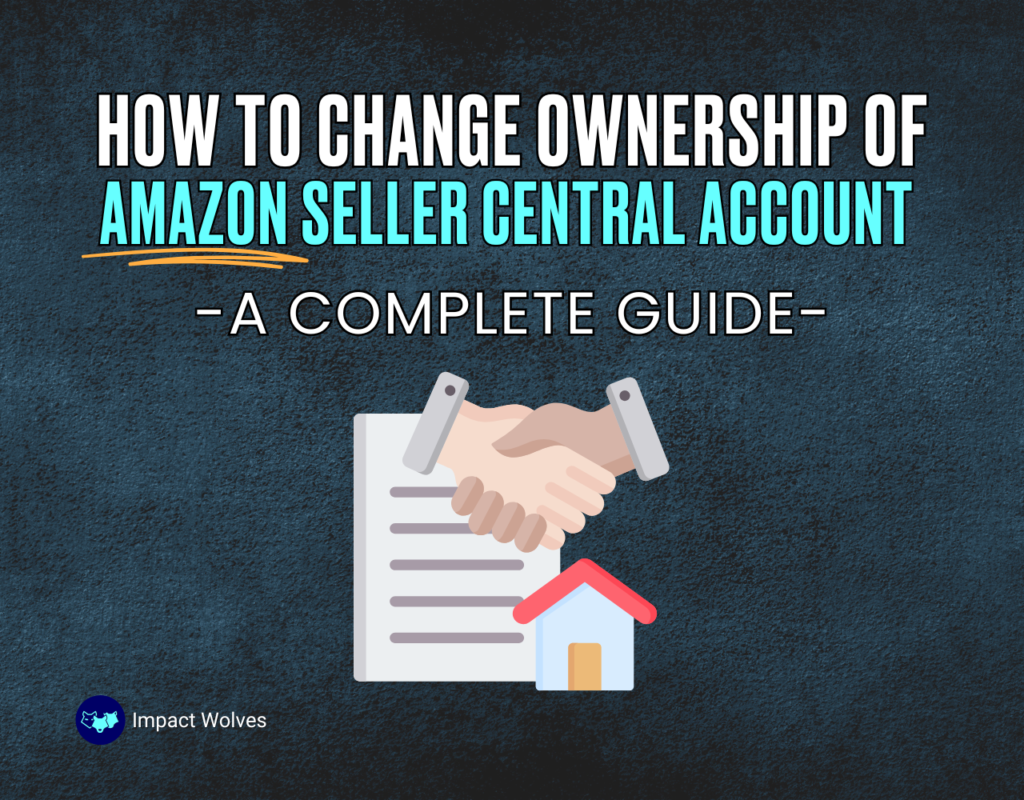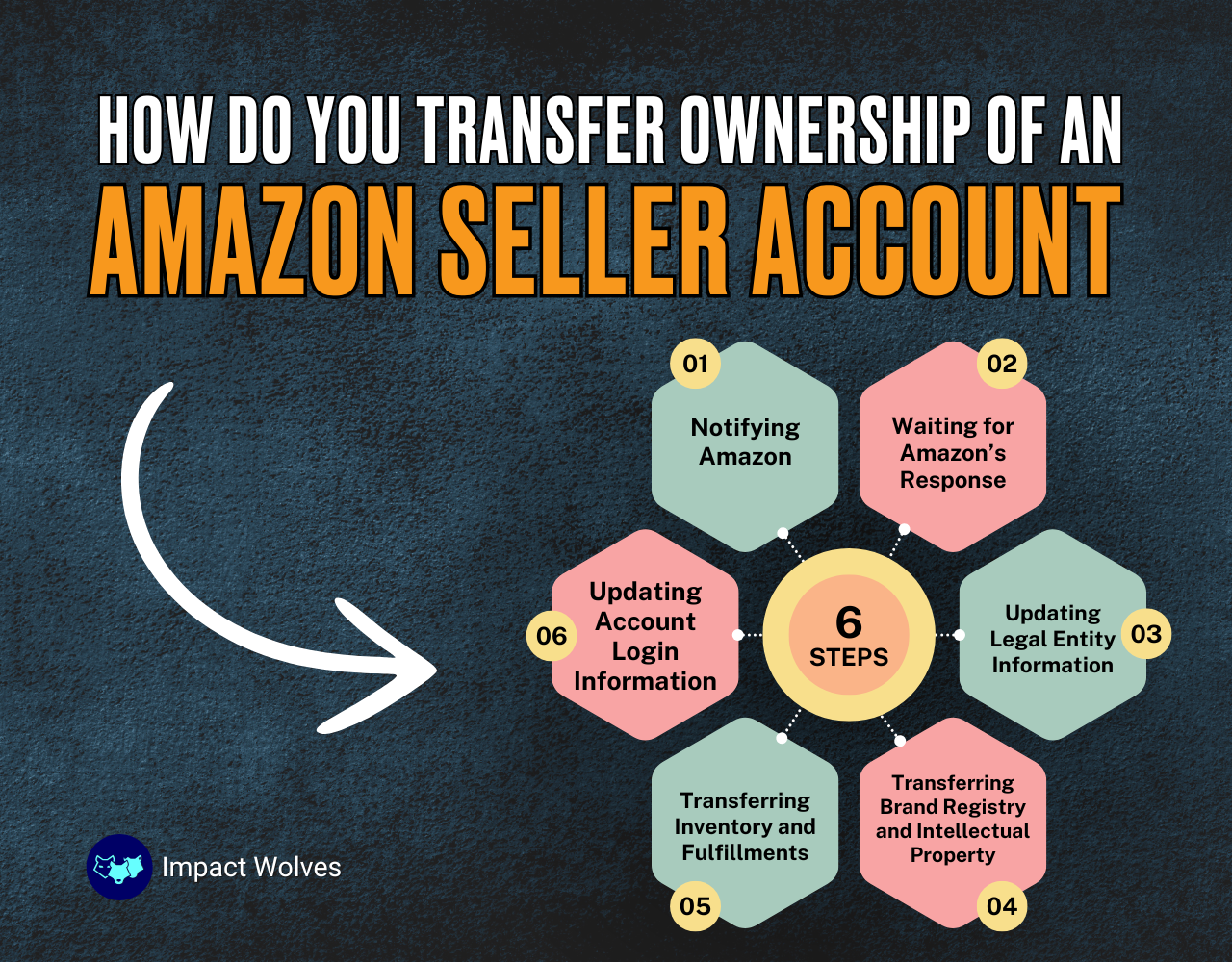Has your business seen its prime on Amazon and now you’re thinking about going low-key? Do you want to focus on other businesses but still keep your Amazon business running? If yes, then it’s time for an Amazon account ownership change!
Transferring ownership of your Amazon Seller account might feel a bit overwhelming, but it’s an important step to make sure everything goes smoothly during the transition. Also, a smooth transfer is important because it helps you keep a good reputation as a seller, makes sure your creative ideas stay safe, and helps you avoid any legal problems.
Seems a bit too much? Don’t worry; Impact Wolves is here to help you through it! In this guide, we will tell you everything you need to know about how to change ownership of Amazon seller account, the issues you might face, and tips to make the process easier.
Part 1: Can You Transfer Amazon Seller Account?
To put it simply, Amazon has a policy that doesn’t allow for the direct transfer of seller accounts between different people. So, you can’t just pass your account along to someone else.
However, if you’re selling your entire Amazon business, you can transfer ownership. This includes the account, inventory, and any intellectual property.
| Policy | Description |
|---|---|
| No Direct Account Transfer | You cannot directly transfer a seller account. |
| Business Entity Transfer | Transfer the business entity that owns the account to change ownership. |
| Compliance with Terms of Service | The new owner must comply with Amazon’s policies. |
| Verification Process | Amazon may verify the new owner’s information for compliance. |
Transferring an Amazon seller account can be tricky, but if you’re curious about how to find an Amazon storefront, you can explore more in this helpful guide
Part 2: How Do You Transfer Ownership of an Amazon Seller Account?
Transferring the ownership of an Amazon seller account might seem like a long and exhausting process, but it’s not. It’s just like transferring or selling your property, car, or any other thing in real life, which requires some documentation, proper communication, and, of course, preparation.
So, here’s how it goes:
Step 1: Notifying Amazon
To change the ownership of your Amazon seller account, first talk to Amazon Seller Support. Just tell them that you want to transfer the account to someone else.
Next, provide details about the buyer, including their:
- Legal name
- Business name
- Contact information
It’s a straightforward process, and they’re there to help you along the way.
Step 2: Waiting for Amazon’s Response
Once you have informed Amazon, you’ll have to wait for a few days for their response. They’ll check your message, make sure everything is in place, and get back to you by email with simple steps for transferring your account.
Step 3: Updating Legal Entity Information
Now that you have Amazon’s permission to transfer your account, you can update your seller account with the details of the new owner.
| Steps | Details |
|---|---|
| Step 1 | Login to your Seller Central account and go to the “Settings” section. |
| Step 2 | Update the account details with the buyer’s details. This includes updating:
|
| Step 3 | Amazon may require some additional documentation, such as:
|
| Step 4 | Sellers from the US may need to provide:
|
| Step 5 | Sellers from outside the US will have to submit:
|
Step 4: Transferring Brand Registry and Intellectual Property
If you’ve joined the Amazon Brand Registry, you will have to transfer the ownership of the brand to the new buyer as well. Amazon will guide you step-by-step and tell you exactly what documents you need to provide.
Also, don’t forget to transfer any intellectual property rights, like trademarks or patents, to the new owner.
Step 5: Transferring Inventory and Fulfillments
To make sure the transfer of your inventory goes smoothly, work together with the buyer. You can either move the stock to them, or both of you can update your inventory records to reflect the transfer. If you use Fulfillment by Amazon (FBA), contact Amazon to help move the FBA inventory to the new owner’s account.
How to Sell on Amazon Without Inventory
For Detailed Insights
Step 6: Updating Account Login Information
Now that all the legal documentation and formalities have been taken care of, it’s time for one final change: updating the primary email address and password associated with the Seller Central account to the new owner’s email.
Once the ownership transfer process is complete, you might also want to explore how to enhance your Amazon presence. A great place to start is with Amazon’s Brand Story feature, which can help tell your brand’s story in a compelling way.
Part 3: Key Things to Remember When Transferring Amazon Seller Account Ownership
Moving your Amazon Seller Account can be easy if you plan carefully and pay close attention to the details.
Here are some helpful tips to make it go smoothly:
Maintain Account Health
- Following all of Amazon’s rules
- Getting orders to customers on time
- Making sure your customers are happy
This will keep your account in good shape. When your account is well-maintained, it’s worth more and it will be easier to transfer it in the future.
Address Existing Reviews and Ratings
Reviews matter a lot on Amazon! People pay close attention to what other customers say about you. So:
- If you have any bad reviews or complaints, it’s best to try to fix those problems before you sell your account.
- Good reviews are a big advantage! When your account has lots of happy customer feedback, it’s worth more money and looks more appealing to someone who wants to buy it.
Transparency is Key
When you’re selling your account, it’s really important to be honest and tell the buyer everything they need to know.
This means:
- Sharing how well the account has been doing.
- Telling them about any problems you’re having with it.
- Letting them know about any risks they might face.
If you talk to the buyer and Amazon in a friendly and helpful way, it will help everyone trust each other more. This will make things go smoother and help you avoid any problems later on.
Learn more about using these reports in How Amazon Seller Central Reports Can Help Grow Your Business.
Seek Professional Guidance
Before selling your Amazon business, you should talk to an Amazon PPC expert, someone who helps sell businesses or a business lawyer. They can give you good advice to make sure everything goes smoothly and is legal. They can also help you understand the legal and tax things you need to know so you can sell your business with confidence.
Document Everything
Finally, the most important thing is to keep careful records of everything related to the transfer. This includes:
- All conversations, agreements, and deals.
- All your account activity, like sales, how much inventory you have, and how you talk to your customers.
By remembering these things and asking for help from experts, you can make your Amazon account transfer go much easier and be more successful.
After the transfer is complete and your account is in good shape, you may want to consider how advertising can boost your sales. Understanding the costs involved in Amazon ads will help you plan your next steps more effectively.
Part 4: Can You Transfer Ownership of an Amazon Seller Account to A New Buyer?
Unfortunately, you cannot transfer your Amazon Seller account directly to another person, as it violates Amazon’s policies. However, if you wish to move on, you have the option to sell your entire Amazon business, which includes your Seller account.
To do this, you should:
- Inform Amazon about the sale.
- Update the account with the new owner’s information.
- Ensure that all related assets are transferred properly
It’s important to follow Amazon’s rules when making changes to your account. This helps you avoid problems like account suspension or losing your selling privileges.
If you want to make changes, check Amazon Seller Central. You may also want to talk to a legal professional to ensure you follow their rules. Doing this will protect your account and keep a good relationship with Amazon.
When choosing between transferring ownership or managing your business using different accounts, it may be helpful to understand the differences between Vendor Central and Seller Central.
Amazon Vendor Central vs Seller Central:
What’s the Difference?
After handling the transfer process, get to know how to search for a seller on Amazon to better understand the platform. This can help you navigate your new business setup or find other sellers for reference.
Part 5: How to Increase the Value of Your Amazon Business for the Buyer?
Here are some key strategies to increase the value of your Amazon business for the buyer:
| Optimize Product Listings | Clear images, engaging descriptions, and relevant keywords are important for attracting buyers and improving search rankings. |
| Implement Effective Pricing Strategies | Thorough market research is necessary to find competitive prices. Tools like repricer can help you change prices quickly and increase profits. |
| Make Use of Amazon Advertising | According to a 2022 report, sellers who use sponsored product campaigns via Amazon Ads spent up to 79% less per click compared to alternative options. So, use sponsored products, display ads, and other advertising options to boost visibility and increase sales. |
| Expand Product Lines | Think about adding related products or trying new product types to increase your income sources. |
| Automate Processes | Use tools and software to automate tasks like managing inventory, fulfilling orders, and handling customer service. |
| Optimize Fulfillment | Consider using Fulfillment by Amazon (FBA) to make order fulfillment easier and speed up delivery times. Plus, it costs 70% less per unit than other fulfillment services. |
| Provide Top-notch Customer Service | Respond quickly to customer questions, fix problems effectively, and go beyond what customers expect. |
| Encourage Positive Reviews | Ask happy customers for reviews and address any negative feedback quickly. |
| Build a Loyal Customer Base | Create loyalty programs or special offers to encourage customers to buy again. |
| Identify Your Competitive Advantages | Find out what makes your business different from your competitors. This could be special product lines, strong brand recognition, or a unique way of selling. |
| Communicate Your USPs | Clearly explain your unique selling points to potential buyers. Highlight their value and the potential for future growth. |
| Maintain Accurate Financial Records | Make sure to keep good track of all your income, expenses, and financial transactions. |
| Prepare Financial Statements | Prepare clear and concise financial statements, including profit and loss statements, balance sheets, and cash flow statements. |
| Demonstrate Consistent Growth | Showcase a history of consistent sales growth and profitability. |
Along with boosting sales and profitability, tracking your advertising costs can provide valuable insights. Understanding Amazon ACoS (Advertising Cost of Sale) will help you optimize your ad spend and maximize profits.
Part 6: Recommendations on Choosing Between a Single Large Account and Multiple Small Accounts
Deciding whether to manage one large account or several smaller ones depends on what suits you best. You need to think about your financial goals, how much risk you can handle, and how involved you want to be in managing your finances.
Here are the key differences between both types to help you make an informed decision:
| Aspect | Single Large Account | Multiple Smaller Accounts |
|---|---|---|
| Management | Easier to track and manage | Difficult to manage |
| Risk of Loss | Higher risk because one loss risks everything | Lower risk due to multiple options |
| Flexibility | Less flexible | More flexible |
| Interest Rates | Higher interest rates | Lower interest rates |
| Budgeting | High chance of overspending | Easier to budget and track goals |
| Security | High risk of account compromise | More secure due to compartmentalization |
In other words, we can say that:
- Having one large account is better for people who want simplicity and may earn higher interest rates.
- Having multiple smaller accounts is a good choice for people who want to spread their risk, manage their budget better, and keep their money safe.
Once you’ve decided on managing a single large account or multiple smaller ones, it’s also crucial to consider your shipping options. Knowing whether USPS delivers on weekends can play a key role in planning your delivery timelines.
Problems Encountered When Buying or Selling Amazon Accounts
Even though the process of transferring ownership of an Amazon seller account is not that much of a hassle, the issues that come with it can be a bit overwhelming.
Here are some of the most common problems you might face during the buying and selling of an Amazon account:
1. Scams
- Fake Accounts
Sellers may provide accounts that show higher performance metrics or fake sales history.
- Account Hijacking
Buyers may attempt to gain unauthorized access to the seller’s account after the transaction.
- Phishing and Fraudulent Transactions
Beware of phishing emails, fake websites, and unauthorized payments.
2. Compliance Risks
- Policy Violations
If the seller has an account that has broken policies in the past, like using someone else’s intellectual property or selling banned products, the buyer is at risk of getting suspended or having the account shut down.
- Tax and Legal Issues
Make sure that the seller or buyer is in compliance with all relevant tax laws and regulations.
3. Hidden Liabilities
- Negative Feedback and Customer Complaints
Unresolved customer issues can damage the account’s reputation and negatively impact future sales.
- Inventory and Fulfillment Issues
Discrepancies in inventory levels or outstanding orders can lead to unexpected costs and liabilities.
The challenges in selling or transferring an Amazon account do not have to be done alone, though. A seasoned Amazon Seller Central expert can take you through this process smoothly and stress-free. See how they might help in The Strategic Benefits of Hiring an Amazon Seller Central Expert.
How to Conduct Due Diligence for Secure Transactions?
If you want to carry out a smooth transfer process and avoid all the risks associated with it, here are some tips on conducting due diligence:
Account Verification
Here’s a checklist of things you should verify before you decide on buying an Amazon business:
- Examine sales history, traffic data, customer reviews, and seller performance metrics before deciding on buying an Amazon business.
- Check the account status, look at performance metrics, and review any past policy violations.
- Ask for and review financial statements, like profit and loss statements and balance sheets.
Legal and Compliance Review
To ensure that the transaction takes place smoothly:
- Talk to a lawyer to understand the legal and tax effects of the transaction.
- Comply with all relevant Amazon policies and guidelines.
Secure Communication and Payment
For a safe and secure payment process, we suggest:
- Using secure platforms for all communication, such as encrypted email or video calls.
- Using secure payment methods like escrow services to reduce risks.
Detailed Documentation
Transferring ownership of a business is a serious matter. Therefore, it’s a good idea to:
- Keep detailed records of all communications, agreements, and transactions.
- Clearly document the steps involved in transferring ownership and any changes made to the account.
If you want to buy or sell an Amazon account, doing your research first can help reduce risks. This will make you feel more confident and secure during the process, making it easier for everyone involved.
While ensuring a smooth transaction through due diligence is key, don’t overlook the logistics. Understanding Amazon FBA box size limits can help ensure your inventory is properly managed during the transfer and beyond.
FAQs
Can you change the owner of an Amazon Seller Account?
No, you can’t simply give your Amazon selling account to someone else; Amazon doesn’t allow that!
But you can sell your whole Amazon business, including your selling account. When you sell your business, you need to tell Amazon about the sale and update the account with the new owner’s information.
Can we change the name of our Amazon Seller Account?
Yes, you can change your Amazon Seller Account name. This is often referred to as your “Store Name” or “Display Name.”
Here’s how to do it:
- Log in to Seller Central and go to the “Settings” section.
- Go to “Account Info,” where your current seller name is displayed.
- Click on the “Edit” or “Change” option next to your current name.
- Enter your desired new seller name.
- Save the changes you’ve made.
Can one person have multiple Amazon seller accounts?
Yes, under certain conditions, you can have multiple Amazon Seller accounts. For instance:
- If you sell products from different brands or in different categories, you can have separate accounts.
- If you own multiple businesses, each with its own distinct brand and inventory
However, keep in mind that each account must have a different business address, bank account, and contact information.
Wrapping Up
Whether you’re retiring, launching a new Amazon business, or just want to go underground for some time, you can transfer the ownership of your running Amazon seller account. However, as there is no current Amazon policy allowing the sale of your seller account, you can simply sell your entire Amazon business, including the account.
In this guide, we have walked you through the steps of how to change ownership of Amazon seller account. We have included the recent Amazon policies regarding this matter, important points to remember, and some common issues that you might face. So, regardless of why you want to transfer the ownership of your account, this guide has outlined all the ins and outs of the whole process for your better understanding and smooth transactions.
Need help to understand the whole process and make your account valuable for a potential buyer? Let us help!






